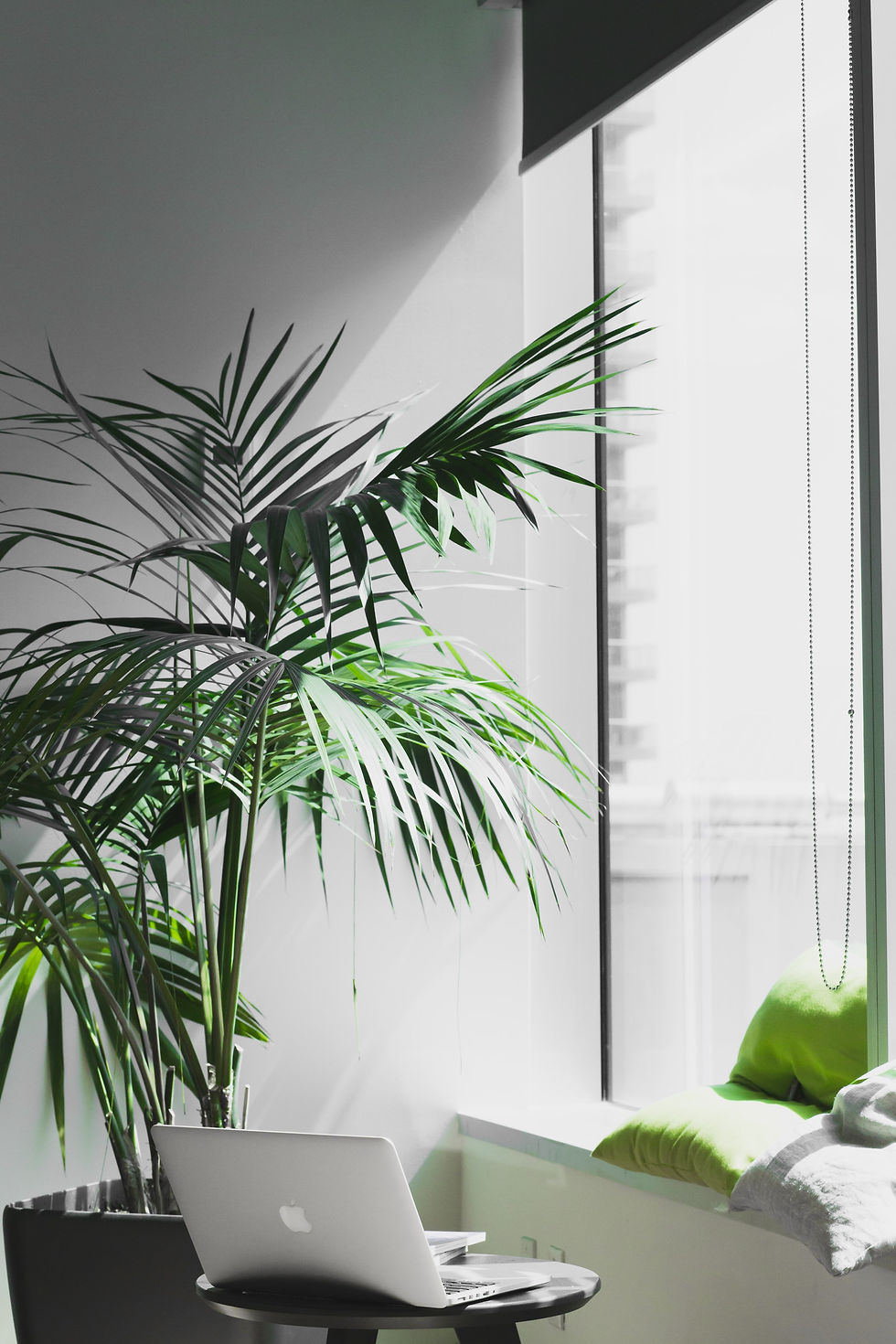Six Ways to Embrace Nature in Your Workspace
- Victoria Grainger

- Apr 8, 2022
- 4 min read
Written by Oluwabukola Bamidele, Msc Arch, Client Relationship Coordinator, Wellness Works Canada
Humans have a deep connection to nature because nature helps us thrive. This human innate need for connection to nature is called Biophilia. Biophilic architecture’ is a growing approach to design and it is based on the principle that an innate connection with nature can assist to make spaces more effective for human functions.
According to the World Green Building Council, there is overwhelming evidence that demonstrates that the design of an office impacts the health, well-being, and productivity of its occupants. This is why there is a growth in the adoption of nature-infused workspaces.

Photo Credit: Alesia Kazantceva on Unsplash
At work, we require a high level of cognitive functioning, which if highly stimulated, could cause mental fatigue and deplete cognitive resources. A momentary interaction such as a simple gaze can give the mind the refreshing “break” it requires to re-sharpen our cognition thus enhancing overall productivity.
Another reason to have elements of nature in a workspace is the aesthetic appeal it adds. Interior designers of luxurious spaces know this well and use at least one element of nature in their designs. An aesthetically pleasing space supports mental well-being better.
These benefits are not unpopular yet the whole nature-infusion idea is often untapped for valid reasons such as cost, space constraints, and maintenance requirements. Featured in this article are six low-budget, low-maintenance, and Do-It-Yourself ideas to spruce up your workspace.
1. Wall Art
Research shows that a visual interaction with nature can boost creativity. You can use nature-inspired wallpaper designs or have your wall painted with nature designs to improve your space to enhance your creativity. You could also make an enlarged print of your happy place. Take those momentary breaks and travel to the space in your mind but be sure to return quickly while at work.

Photo Credit: Sean Oulashin on Unsplash
2. Plants
The traditional office could be a stern reminder of work and for some people, that reminder is an additional pressure. Having an abundance of plants in your office could turn your space into a mini garden that soothes you while at work. With a space that does not wear the traditional office, the subtle pressure from your environment is tapered off. Additionally, having living plants in indoor spaces is known to improve the quality of air because plants breathe in the carbon dioxide we breathe out and in turn produce oxygen.

Using plants in interior spaces is an age-long beneficial practice but limitations such as tending responsibilities and poor thriving conditions often discourage the use of plants. As an alternative, artificial plants can be used to get a natural look in the workspace. If you go this route, try to use realistic dummy plants.
3. Water
Water is one of the most important elements in nature. Proximity to water and aquatic life is associated with many positive measures of physical and mental well-being. For a workplace adaptation, you can have a water wall or a fountain. You can also use an aquarium or a fishbowl with exotic fish. Alternatively, using dummy fish removes the feeding and cleaning tasks. For some styles, resin can also be used in place of water.

4. Work Pet
If your favourite part of nature is the animal kingdom, you could consider having an office pet or a work pet. Having a pet is known to help decrease blood pressure, cholesterol levels, triglyceride levels, feelings of loneliness, anxiety, and symptoms of PTSD. A helpful tip is to choose one that supports your well-being without distraction. When choosing a pet, it is important to consider the care responsibilities involved. An alternative is to have a life-size dummy image of the pet to eliminate all the responsibilities.

Photo Credit: Alex Konokh on Unsplash
5. Window View
One of the reasons a corner office in a high-rise building is desirable is the expansive panoramic view that often comes with it. That a window view could be a source of inspiration is what makes it important. However, not everyone can get their preferred view of the world from their windows.

Photo Credit: Sebastian Staines on Unsplash
A possible intervention is to have a customizable window tint with an image of your desired view. It could be a print of a sunny day, a rainy day, a forest view in fall, a riverbank or any natural view that puts you in a good mood.
6. Wood
Wood is a plant derivative but could be acknowledged as a separate element of nature. Despite the newness of the study of our psychophysiological responses to wood, there is available evidence that wood surroundings can help to reduce stress. Wood is very versatile, so can be used in many ways. It is fitting for decorative use and functional use.

Photo credit: Luca Bravo on Unsplash
To make the best of wood as a connection to nature, it is best to retain its natural look. Your wood feature could be your wall, worktable, a wooden sculpture or even your window blinds.
As you look at creating a better workspace, enjoy finding your muse to spruce up your workspace in a way that suits you or your organization. Wall art, plants, water, work pets, windows, and wood are all great options. Be sure to keep exploring new ideas to enhance your physical workplace to support you to be well and perform well.

About the Author
Oluwabukola is a Graduate Student of the Workplace Wellness and Health Promotion program at Centennial College. She has a background in Architecture and is passionate about healthy
living. As a pastime, she loves to watch documentaries, especially those that feature massive building constructions, the animal world, and outer space.
References
Söderlund, J., & Newman, P. (2015). Biophilic Architecture: A review of the rationale and outcomes. AIMS Environmental Science. Retrieved March 23, 2022, from https://www.aimspress.com/article/id/555
Plants need CO2 to live. So is more of it a good thing? Climate Central. (November 7th, 2009). Retrieved March 22, 2022, from https://www.climatecentral.org/library/faqs/plants_need_CO2_to_live_so_isnt_more_of_it_a_good_thing
The business case for Green Building: A review of the costs and benefits for developers, investors and occupants. World Green Building Council. (2013). Retrieved March 23, 2022, from https://www.worldgbc.org/news-media/business-case-green-building-review-costs-and-benefits-developers-investors-and-occupants
Graham Lowe, Wood, wellbeing, and performance: How workers thrive in wood buildings. Work in Mind. (2020, December 17). Retrieved March 10, 2022, from https://workinmind.org/2020/07/08/wood-wellbeing-and-performance-how-workers-thrive-in-wood-buildings/
Blue spaces: why time spent near water is the secret of happiness. Retrieved March 10, 2022, from https://www.theguardian.com/lifeandstyle/2019/nov/03/blue-space-living-near-water-good-secret-of-happiness
CDC, How to Stay Healthy Around Pet (2021, September). Retrieved March 15, 2022, from https://www.cdc.gov/healthypets/keeping-pets-and-people-healthy/how.html
![wwc-logo-transparent-png.png[80].png](https://static.wixstatic.com/media/6884e0_850f8b03110649f2892fc04639a82ea1~mv2.png/v1/fill/w_104,h_69,al_c,q_85,usm_0.66_1.00_0.01,enc_avif,quality_auto/wwc-logo-transparent-png_png%5B80%5D.png)



Comments